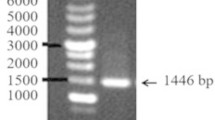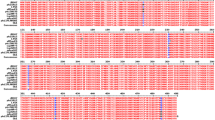Abstract
The increasing rate of resistance of pathogenic bacteria, such as Staphylococcus aureus, to classical antibiotics has driven research toward identification of other means to fight infectious disease. One particularly viable option is the use of bacteriophage-encoded peptidoglycan hydrolases, called endolysins or enzybiotics. These enzymes lyse the bacterial cell wall upon direct contact, are not inhibited by traditional antibiotic resistance mechanisms, and have already shown great promise in the areas of food safety, human health, and veterinary science. We have identified and characterized an endolysin, PlyGRCS, which displays dose-dependent antimicrobial activity against both planktonic and biofilm S. aureus, including methicillin-resistant S. aureus (MRSA). The spectrum of lytic activity for this enzyme includes all S. aureus and Staphylococcus epidermidis strains tested, but not other Gram-positive pathogens. The contributions of the PlyGRCS putative catalytic and cell wall binding domains were investigated through deletion analysis. The cysteine, histidine-dependent amidohydrolase/peptidase (CHAP) catalytic domain displayed activity by itself, though reduced, indicating the necessity of the binding domain for full activity. In contrast, the SH3_5 binding domain lacked activity but was shown to interact directly with the staphylococcal cell wall via fluorescent microscopy. Site-directed mutagenesis studies determined that the active site residues in the CHAP catalytic domain were C29 and H92, and its catalytic functionality required calcium as a co-factor. Finally, biochemical assays coupled with mass spectrometry analysis determined that PlyGRCS displays both N-acetylmuramoyl-l-alanine amidase and d-alanyl-glycyl endopeptidase hydrolytic activities despite possessing only a single catalytic domain. These results indicate that PlyGRCS has the potential to become a revolutionary therapeutic option to combat bacterial infections.






Similar content being viewed by others
References
Abedon ST (2011) Lysis from without. Bacteriophage 1(1):46–49. doi:10.4161/bact.1.1.13980
Atilano ML, Pereira PM, Yates J, Reed P, Veiga H, Pinho MG, Filipe SR (2010) Teichoic acids are temporal and spatial regulators of peptidoglycan cross-linking in Staphylococcus aureus. Proc Natl Acad Sci U S A 107(44):18991–18996. doi:10.1073/pnas.1004304107
Bateman A, Rawlings ND (2003) The CHAP domain: a large family of amidases including GSP amidase and peptidoglycan hydrolases. Trends Biochem Sci 28(5):234–237. doi:10.1016/S0968-0004(03)00061-6
Becker SC, Foster-Frey J, Donovan DM (2008) The phage K lytic enzyme LysK and lysostaphin act synergistically to kill MRSA. FEMS Microbiol Lett 287(2):185–191. doi:10.1111/j.1574-6968.2008.01308.x
Becker SC, Dong S, Baker JR, Foster-Frey J, Pritchard DG, Donovan DM (2009) LysK CHAP endopeptidase domain is required for lysis of live staphylococcal cells. FEMS Microbiol Lett 294(1):52–60. doi:10.1111/j.1574-6968.2009.01541.x
Borysowski J, Lobocka M, Miedzybrodzki R, Weber-Dabrowska B, Gorski A (2011) Potential of bacteriophages and their lysins in the treatment of MRSA: current status and future perspectives. BioDrugs 25(6):347–355. doi:10.2165/11595610-000000000-00000
CDC (2013) Antibiotic resistance threats in the United States, 2013. Centers for Disease Control and Prevention, Atlanta
Celia LK, Nelson D, Kerr DE (2008) Characterization of a bacteriophage lysin (Ply700) from Streptococcus uberis. Vet Microbiol 130(1–2):107–117. doi:10.1016/j.vetmic.2007.12.004
Danner M, Fuchs A, Miller S, Seckler R (1993) Folding and assembly of phage P22 tailspike endorhamnosidase lacking the N-terminal, head-binding domain. Eur J Biochem 215(3):653–661
Davis KM, Weiser JN (2011) Modifications to the peptidoglycan backbone help bacteria to establish infection. Infect Immun 79(2):562–570. doi:10.1128/IAI.00651-10
Donovan DM, Lardeo M, Foster-Frey J (2006) Lysis of staphylococcal mastitis pathogens by bacteriophage phi11 endolysin. FEMS Microbiol Lett 265(1):133–139. doi:10.1111/j.1574-6968.2006.00483.x
Ekici OD, Paetzel M, Dalbey RE (2008) Unconventional serine proteases: variations on the catalytic Ser/His/Asp triad configuration. Protein Sci Publ Protein Soc 17(12):2023–2037. doi:10.1110/ps.035436.108
Fallas JA, Hartgerink JD (2012) Computational design of self-assembling register-specific collagen heterotrimers. Nat Commun 3:1087. doi:10.1038/ncomms2084
Fenton M, Ross RP, McAuliffe O, O’Mahony J, Coffey A (2011) Characterization of the staphylococcal bacteriophage lysin CHAP(K). J Appl Microbiol 111(4):1025–1035. doi:10.1111/j.1365-2672.2011.05119.x
Filatova LY, Becker SC, Donovan DM, Gladilin AK, Klyachko NL (2010) LysK, the enzyme lysing Staphylococcus aureus cells: specific kinetic features and approaches towards stabilization. Biochimie 92(5):507–513. doi:10.1016/j.biochi.2010.01.026
Fischetti VA (2005) Bacteriophage lytic enzymes: novel anti-infectives. Trends Microbiol 13(10):491–496. doi:10.1016/j.tim.2005.08.007
Garcia P, Martinez B, Rodriguez L, Rodriguez A (2010) Synergy between the phage endolysin LysH5 and nisin to kill Staphylococcus aureus in pasteurized milk. Int J Food Microbiol 141(3):151–155. doi:10.1016/j.ijfoodmicro.2010.04.029
Gilmer DB, Schmitz JE, Euler CW, Fischetti VA (2013) Novel bacteriophage lysin with broad lytic activity protects against mixed infection by Streptococcus pyogenes and methicillin-resistant Staphylococcus aureus. Antimicrob Agents Chemother 57(6):2743–2750. doi:10.1128/AAC.02526-12
Gu J, Feng Y, Feng X, Sun C, Lei L, Ding W, Niu F, Jiao L, Yang M, Li Y, Liu X, Song J, Cui Z, Han D, Du C, Yang Y, Ouyang S, Liu ZJ, Han W (2014) Structural and biochemical characterization reveals LysGH15 as an unprecedented “EF-hand-like” calcium-binding phage lysin. PLoS Pathog 10(5):e1004109. doi:10.1371/journal.ppat.1004109
Howden BP, Davies JK, Johnson PD, Stinear TP, Grayson ML (2010) Reduced vancomycin susceptibility in Staphylococcus aureus, including vancomycin-intermediate and heterogeneous vancomycin-intermediate strains: resistance mechanisms, laboratory detection, and clinical implications. Clin Microbiol Rev 23(1):99–139. doi:10.1128/CMR.00042-09
Huang SS, Septimus E, Kleinman K, Moody J, Hickok J, Avery TR, Lankiewicz J, Gombosev A, Terpstra L, Hartford F, Hayden MK, Jernigan JA, Weinstein RA, Fraser VJ, Haffenreffer K, Cui E, Kaganov RE, Lolans K, Perlin JB, Platt R, Program CDCPE, Network AD, Healthcare-Associated Infections P (2013) Targeted versus universal decolonization to prevent ICU infection. N Engl J Med 368(24):2255–2265. doi:10.1056/NEJMoa1207290
Jones R, Barry AL, Gavan T et al (1985) Susceptibility tests: microdilution and macrodilution broth procedures. In: Balows A, Hausler J, Shadomy H (eds) Manual of clinical microbiology. American Society for Microbiology, Washington, DC, pp 972–977
Jun SY, Jung GM, Son JS, Yoon SJ, Choi YJ, Kang SH (2011) Comparison of the antibacterial properties of phage endolysins SAL-1 and LysK. Antimicrob Agents Chemother 55(4):1764–1767. doi:10.1128/AAC.01097-10
Khayat R, Batra R, Massariol MJ, Lagace L, Tong L (2001) Investigating the role of histidine 157 in the catalytic activity of human cytomegalovirus protease. Biochemistry 40(21):6344–6351
Kusuma CM, Kokai-Kun JF (2005) Comparison of four methods for determining lysostaphin susceptibility of various strains of Staphylococcus aureus. Antimicrob Agents Chemother 49(8):3256–3263. doi:10.1128/AAC.49.8.3256-3263.2005
Loeffler JM, Fischetti VA (2003) Synergistic lethal effect of a combination of phage lytic enzymes with different activities on penicillin-sensitive and -resistant Streptococcus pneumoniae strains. Antimicrob Agents Chemother 47(1):375–377
Low LY, Yang C, Perego M, Osterman A, Liddington R (2011) Role of net charge on catalytic domain and influence of cell wall binding domain on bactericidal activity, specificity, and host range of phage lysins. J Biol Chem 286(39):34391–34403. doi:10.1074/jbc.M111.244160
Lowy FD (1998) Staphylococcus aureus infections. N Engl J Med 339(8):520–532. doi:10.1056/NEJM199808203390806
McGowan S, Buckle AM, Mitchell MS, Hoopes JT, Gallagher DT, Heselpoth RD, Shen Y, Reboul CF, Law RH, Fischetti VA, Whisstock JC, Nelson DC (2012) X-ray crystal structure of the streptococcal specific phage lysin PlyC. Proc Natl Acad Sci U S A 109(31):12752–12757. doi:10.1073/pnas.1208424109
Micek ST (2007) Alternatives to vancomycin for the treatment of methicillin-resistant Staphylococcus aureus infections. Clin Infect Dis Off Publ Infect Dis Soc Am 45(Suppl 3):S184–S190. doi:10.1086/519471
Mokrasch L (1967) Use of 2,4,6-trinitrobenzenesulfonic acid for the coestimation of amines, amino acids, and proteins in mixtures. Anal Biochem 18:64–71
Nelson DC, Schmelcher M, Rodriguez-Rubio L, Klumpp J, Pritchard DG, Dong S, Donovan DM (2012) Endolysins as antimicrobials. Adv Virus Res 83:299–365. doi:10.1016/B978-0-12-394438-2.00007-4
Pritchard DG, Dong S, Baker JR, Engler JA (2004) The bifunctional peptidoglycan lysin of Streptococcus agalactiae bacteriophage B30. Microbiology 150(Pt 7):2079–2087. doi:10.1099/mic.0.27063-0
Provencher SW, Glockner J (1981) Estimation of globular protein secondary structure from circular dichroism. Biochemistry 20(1):33–37
Rigden DJ, Jedrzejas MJ, Galperin MY (2003) Amidase domains from bacterial and phage autolysins define a family of gamma-D, L-glutamate-specific amidohydrolases. Trends Biochem Sci 28(5):230–234
Sanz JM, Garcia JL, Laynez J, Usobiaga P, Menendez M (1993) Thermal stability and cooperative domains of CPL1 lysozyme and its NH2- and COOH-terminal modules. Dependence on choline binding. J Biol Chem 268(9):6125–6130
Sass P, Bierbaum G (2007) Lytic activity of recombinant bacteriophage phi11 and phi12 endolysins on whole cells and biofilms of Staphylococcus aureus. Appl Environ Microbiol 73(1):347–352. doi:10.1128/AEM.01616-06
Satake M, Mase K, Takahashi Y, Ogata K (1960) Incorporation of leucine into microsomal protein by a cell-free system of guinea-pig brain. Biochim Biophys Acta 41:366–367
Schmelcher M, Donovan DM, Loessner MJ (2012a) Bacteriophage endolysins as novel antimicrobials. Future Microbiol 7(10):1147–1171. doi:10.2217/fmb.12.97
Schmelcher M, Powell AM, Becker SC, Camp MJ, Donovan DM (2012b) Chimeric phage lysins act synergistically with lysostaphin to kill mastitis-causing Staphylococcus aureus in murine mammary glands. Appl Environ Microbiol 78(7):2297–2305. doi:10.1128/AEM.07050-11
Schmelcher M, Waldherr F, Loessner MJ (2012c) Listeria bacteriophage peptidoglycan hydrolases feature high thermoresistance and reveal increased activity after divalent metal cation substitution. Appl Microbiol Biotechnol 93(2):633–643. doi:10.1007/s00253-011-3372-6
Schuch R, Nelson D, Fischetti VA (2002) A bacteriolytic agent that detects and kills Bacillus anthracis. Nature 418(6900):884–889. doi:10.1038/nature01026
Schuch R, Lee HM, Schneider BC, Sauve KL, Law C, Khan BK, Rotolo JA, Horiuchi Y, Couto DE, Raz A, Fischetti VA, Huang DB, Nowinski RC, Wittekind M (2013) Combination therapy with lysin CF-301 and antibiotic is superior to antibiotic alone for treating methicillin-resistant Staphylococcus aureus-induced murine bacteremia. J Infect Dis. doi:10.1093/infdis/jit637
Shen Y, Mitchell M, Donovan DM, Nelson DC (2012) Phage-based enzybiotics. In: Abedon S, Hyman P (eds) Bacteriophages in health and disease. CABI Press, pp 217–239
Sieradzki K, Tomasz A (2003) Alterations of cell wall structure and metabolism accompany reduced susceptibility to vancomycin in an isogenic series of clinical isolates of Staphylococcus aureus. J Bacteriol 185(24):7103–7110
Son B, Yun J, Lim JA, Shin H, Heu S, Ryu S (2012) Characterization of LysB4, an endolysin from the Bacillus cereus-infecting bacteriophage B4. BMC Microbiol 12:33. doi:10.1186/1471-2180-12-33
Spratt BG (1994) Resistance to antibiotics mediated by target alterations. Science 264(5157):388–393
Sunagar R, Patil SA, Chandrakanth RK (2010) Bacteriophage therapy for Staphylococcus aureus bacteremia in streptozotocin-induced diabetic mice. Res Microbiol 161(10):854–860. doi:10.1016/j.resmic.2010.09.011
Swift SM, Nelson DC (2014) Complete genome sequence of Staphylococcus aureus phage GRCS. Genome Announc 2(2) doi:10.1128/genomeA.00209-14
Tang YW, Stratton CW (2010) Staphylococcus aureus: an old pathogen with new weapons. Clin Lab Med 30(1):179–208. doi:10.1016/j.cll.2010.01.005
Taubes G (2008) The bacteria fight back. Science 321(5887):356–361. doi:10.1126/science.321.5887.356
Vollmer W (2008) Structural variation in the glycan strands of bacterial peptidoglycan. FEMS Microbiol Rev 32(2):287–306. doi:10.1111/j.1574-6976.2007.00088.x
Weidenmaier C, Kokai-Kun JF, Kristian SA, Chanturiya T, Kalbacher H, Gross M, Nicholson G, Neumeister B, Mond JJ, Peschel A (2004) Role of teichoic acids in Staphylococcus aureus nasal colonization, a major risk factor in nosocomial infections. Nat Med 10(3):243–245. doi:10.1038/nm991
Whitmore L, Wallace BA (2004) DICHROWEB, an online server for protein secondary structure analyses from circular dichroism spectroscopic data. Nucleic Acids Res 32(Web Server issue):W668-73 doi:10.1093/nar/gkh371
Acknowledgments
This work was supported by a grant from the U.S. Department of Defense (DM102823) to DCN. The SA113 ΔtagO strain was a generous gift from Andreas Peschel, Medical Microbiology and Hygiene Department, University of Tübingen, Tübingen, Germany.
Author information
Authors and Affiliations
Corresponding author
Rights and permissions
About this article
Cite this article
Linden, S.B., Zhang, H., Heselpoth, R.D. et al. Biochemical and biophysical characterization of PlyGRCS, a bacteriophage endolysin active against methicillin-resistant Staphylococcus aureus . Appl Microbiol Biotechnol 99, 741–752 (2015). https://doi.org/10.1007/s00253-014-5930-1
Received:
Revised:
Accepted:
Published:
Issue Date:
DOI: https://doi.org/10.1007/s00253-014-5930-1




